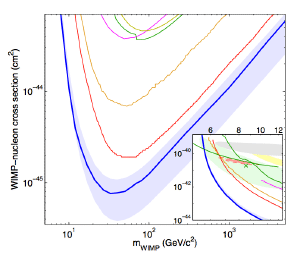Blog
Much Ado About Nothing
2 November 2013
This week the initial findings of a dark matter experiment known as LUX (Large Underground Xenon detector). The team announced, and summarized in a paper1 being submitted to Physical Review Letters, the fact that they had found no evidence of dark matter particles. The results haven’t been peer reviewed yet, but I have no doubt they will pass muster.
You might wonder why anyone would announce that they had found nothing. Isn’t science about discovering things? Finding nothing is pointless because you can’t prove a negative, right? Not quite. It actually depends on the type of nothing you’ve found.
Take for example the search for the Higgs boson. The Higgs boson was first proposed in 1964 as a way to explain why some fundamental particles have mass and others don’t. It soon became part of the standard model of particle physics, which has shown to be a very good model for fundamental particles. Barring more exotic versions of the Higgs, the standard model places the mass of the Higgs at somewhere between 115 and 180 times that of the proton mass.
This range was accessible by the Large Hadron Collider, so if the LHC had run all their tests and found nothing, this would have demonstrated that the standard model was wrong. Either there was no Higgs boson, or it must have a more exotic form. Not finding the Higgs boson would have been a very big deal, and it would have sent particle physicists off to look at alternative theories. However we diddiscover the Higgs boson at about 125 proton masses, so the standard model remains valid.
So does the fact that LUX didn’t discover any dark matter particles mean that the dark matter model must be discarded? No, because in the case of dark matter things are a little different. For the Higgs boson, it was proposed to explain something about particle physics. It had the advantage of being a relatively simple (if particle physics can be called simple) model, but it wasn’t the only one. It was a prediction of a theory that worked, but didn’t have any indirect evidence supporting it.
Dark matter actually has a great deal of evidence supporting it. I’ve written a series of posts a while back outlining all the evidence supporting it, including galactic rotation curves, the distrubution of dark matter in the bullet cluster and others, gravitational lensing effects and the baryon acoustic oscillation. Dark matter is strongly supported by observational evidence, which was not the case for the Higgs. We know that dark matter exists, but we don’t know the specific nature of dark matter.
Since we don’t have any evidence on the specific nature of dark matter particles (often called WIMPS, or Weakly Interacting Massive Particles), there are lots of theories as to what they might be. Each of these theories has a particular set of predictions, and if we don’t see those predictions in the experiments, then we can exclude them from the pool. That is what has happened in this case. Some interesting theories have been eliminated.
In other dark matter experiments, such as the CDMS experiment in Minnesota I visited this summer had some interesting results that hinted at dark matter WIMPS with a mass of 5 – 10 protons. This raised a lot of eyebrows because mass for mass there is about 6 times more dark matter than regular matter. If dark matter WIMPS had a mass of 6 protons, that would mean there would be one dark matter particle for every baryon (proton or neutron).

The new results from LUX throw this idea out the window. While it’s said that the LUX experiment found nothing, what they actually found was that there are no dark matter particles with a certain combination of mass and interaction strength (what we call a cross section). You can see the result in the figure, which is taken from the paper. Of particular interest is the inset square. The blue line represents the limit for which LUX found nothing. Anything above and to the right of that line is experimentally excluded by the LUX results. The pale green region of the inset indicates the range where “tantalizing hints” from CDMS were. As you can see, those hints are well within the excluded region.
So models that propose a one-to-one relation between WIMPS and baryons are now pretty much eliminated from possibility. What ever dark matter is, it doesn’t seem to be paired with baryons in a simple way. There are other possibilities for dark matter WIMPS, so they are still possible. Future experiments will either find them, or rule them out.
Sometimes finding nothing is scientific progress, if it is the right kind of nothing.
Akerib, Daniel S., et al. “First results from the LUX dark matter experiment at the Sanford Underground Research Facility.” Physical review letters 112.9 (2014): 091303. ↩︎